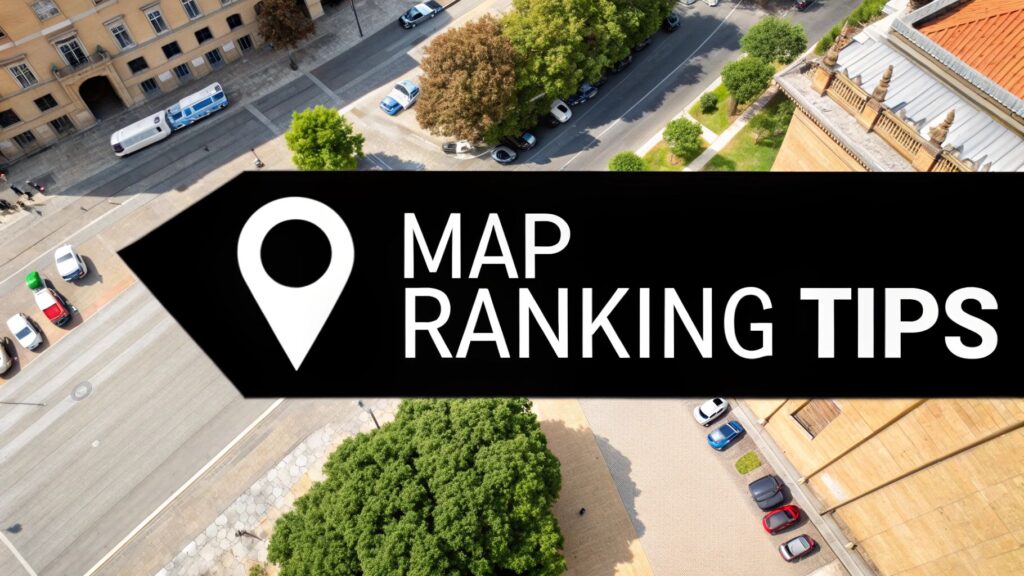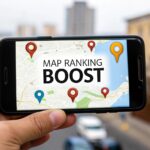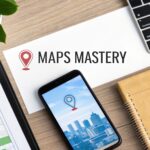Getting your business into the Google Map Pack isn't about secret SEO tricks. It’s about following Google's rules and proving you're the best local answer for a search.
When you get this right, you land in the top 3-pack of search results. This is a game-changer for getting more calls, website clicks, and customers.
What Is The Google Map Pack and Why Is It Important?
When you search for something like "pizza delivery near me," you see a small box at the top of Google. It has a map and three business listings. That's the Google Map Pack, also known as the Local Pack.
Appearing here is like having a storefront on the busiest street in town. You're right at the top, above all other organic results. For a local business, this is the fastest way to connect with customers ready to buy.
In Short: The Google Map Pack is the group of three local business listings that appear at the top of Google search results for local queries.
Google's Big Three: Relevance, Distance, and Prominence
Google's local algorithm focuses on three main ideas. If you master these, you're on your way to a top ranking.
- Relevance: How well does your business match what the user is searching for? If your Google Business Profile lists "emergency plumbing," you're relevant for a "burst pipe repair" search.
- Distance: How close is your business to the person searching? Google favors businesses that are physically closer to the user's location.
- Prominence: How well-known is your business online? Google looks at your online reviews, how many other websites mention you (citations), and your website's authority.
These three factors work together to support your ranking.

This table breaks down what each pillar means for your strategy.
The Three Pillars of Google Map Pack Ranking
| Pillar | What It Means for Your Business | Quick Win |
|---|---|---|
| Relevance | Your Google Business Profile must perfectly match the services you offer and what customers search for. | Add detailed descriptions and all relevant services to your Google Business Profile. |
| Distance | Google uses the searcher's location to provide the most convenient results. You can't change your address, but you can define your service area. | Make sure your address is 100% correct on your GBP and set your service areas if you travel to customers. |
| Prominence | This is your online reputation. Google trusts businesses that are well-regarded across the web. | Actively ask every happy customer for a Google review. More positive reviews build authority. |
Understanding these three pillars is the foundation of any local SEO campaign.
Why You Can't Ignore the Map Pack
A spot in the Map Pack directly impacts your bottom line. The click-through rate for businesses in the 3-pack is huge compared to those just below it.
The top spot in the Local Pack gets a 17.6% click-through rate (CTR). The second and third spots get 15.4% and 15.1%. Together, they receive almost half of all clicks for a local search.
If you're in the fourth position (the first one below the map), your CTR drops to just 7.2%. You can see more data on Google click-through rates, but the point is clear: if you're not in the pack, you're nearly invisible.
This guide will show you the exact steps to optimize your online presence, build local authority, and attract more local customers.
How to Optimize Your Google Business Profile for the Map Pack
Your Google Business Profile (GBP) is the starting point for any google map pack ranking effort. Think of it as the foundation of your local SEO. An incomplete profile is like a "Closed" sign. A well-managed one works 24/7 to bring in new customers.
Every field in your profile is a chance to tell Google and customers who you are and what you do. This is more than data entry; it's a strategic move.
Start With Your Business Categories
Choosing the right primary category is your most important first step. This single choice greatly impacts which searches you appear in. Be as specific as possible.
For example, if you're a lawyer who handles car accidents, "Law Firm" is too broad. "Personal Injury Attorney" is much better because it tells Google exactly who to send to you.
After setting your primary category, add secondary categories for your other services. This helps you reach a wider audience.
- For a Plumber: Your primary category could be "Plumber." Add secondary ones like "Water Heater Repair Service" and "Drain Cleaning Service."
- For a Restaurant: An "Italian Restaurant" can also add "Pizza Delivery," "Catering," and "Pasta Shop."
Write a Business Description That Works
Your business description is your elevator pitch. It should appeal to customers while also signaling to Google what you do. Write for people first, but include important keywords.
Avoid keyword stuffing like "Plumber Dallas. Dallas Plumber. Best Plumber in Dallas." Instead, tell a brief story.
"We are a family-owned plumbing company serving the Dallas community for over 20 years. From emergency leak repairs to bathroom remodels, our licensed team provides reliable and affordable solutions."
This description is conversational and naturally includes terms like "plumber Dallas," "emergency leak repairs," and "bathroom remodels." For more detail, a comprehensive guide to Google My Business optimization can offer deeper insights.
Bring Your Profile to Life with Photos, Posts, and Q&A
A static profile is an ignored profile. Google rewards businesses that use all of its features because it creates a better user experience.
-
High-Quality Photos: Regularly upload clear photos of your storefront, team, and finished work. Pro tip: Turn on location services on your phone when taking pictures to geo-tag your photos, adding another strong local signal.
-
GBP Posts: Use these like small ads on your profile. Announce sales, showcase recent projects, or share blog posts. Consistent posting shows Google you're active.
-
Q&A Section: Don't wait for customers to ask questions. Add the top 5-10 questions you get and answer them yourself. This gives potential customers the info they need immediately.
All of this is managed from your Google Business Profile dashboard. Use this tool regularly to make updates, chat with customers, and see how people are finding you.
People Also Ask About Google Business Profiles
How many categories can I have on Google Business Profile?
You can have one primary category and up to nine secondary ones. Use as many as are relevant to your business to maximize your visibility.
Does my business name affect my Google Map Pack ranking?
Yes, but be careful. Adding keywords to your business name (like "Joe's Plumbing – Best Plumber in Dallas") can get your profile suspended. Always use your real, registered business name.
How often should I update my Google Business Profile?
Aim to update your profile at least once a week. This could be adding a photo, publishing a Post, or answering a question. Consistency is key. For more tips, learn how to improve Google Maps ranking with ongoing effort.
Building Prominence: Reviews and Citations
After setting up your Google Business Profile, the focus shifts to prominence, which is your online reputation. Google needs to see that you are a trusted and active business in your community before it will feature you in the Map Pack.
Your GBP is what you say about your business. Reviews and citations are what others say. Google pays close attention to what others say.
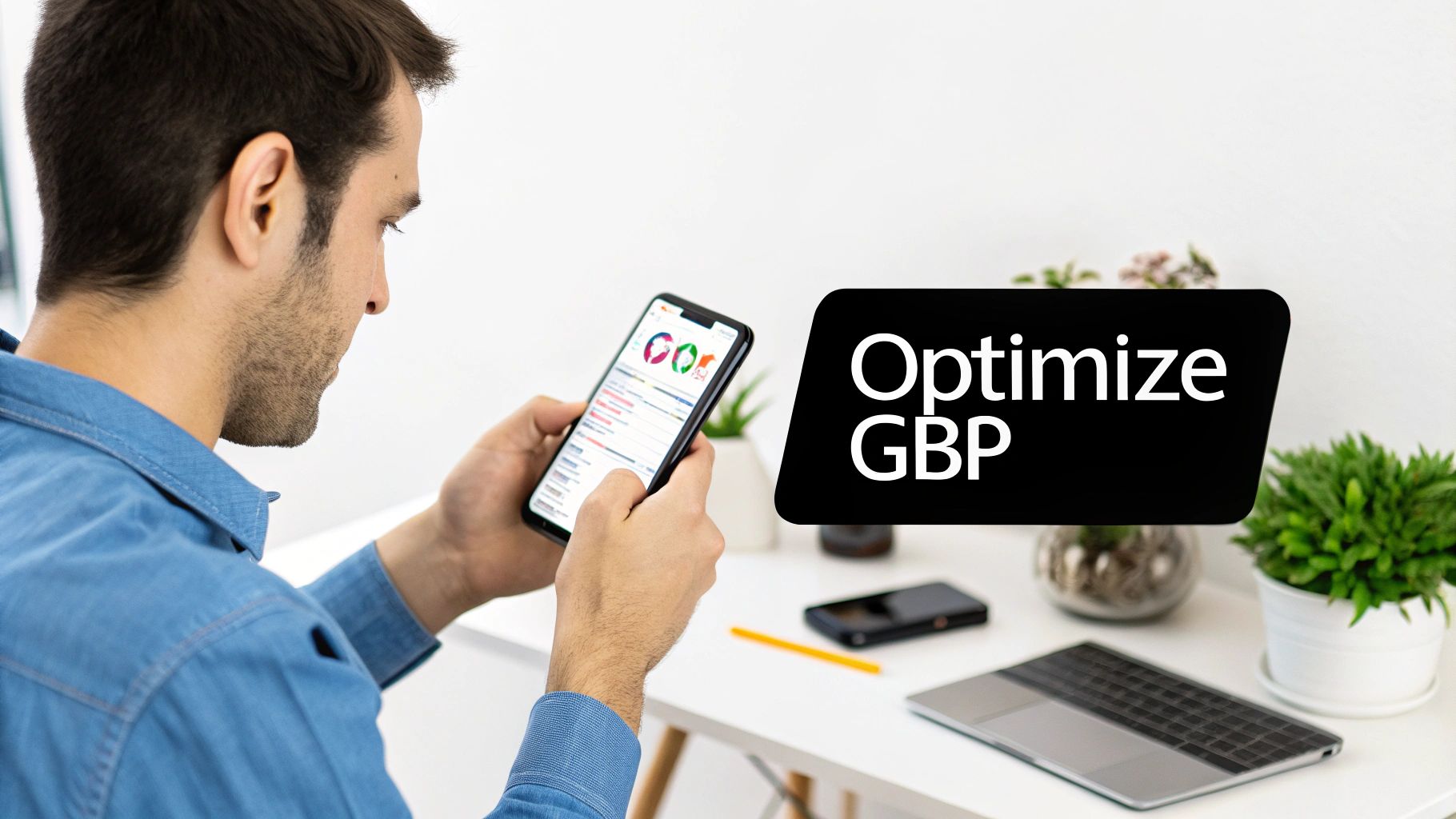
The Power of Online Reviews
Reviews are a huge factor in local SEO. They influence your ranking and are often the first thing a potential customer reads. A steady stream of positive reviews sends a powerful signal to Google.
Businesses in the top 3 of the Map Pack usually have more reviews. The average is about 47 reviews, but the top spot often has 80 or more. Good reviews can boost traffic significantly. Studies show how review counts influence local rankings.
How to Get More Google Reviews
Asking for reviews can feel awkward. The key is to make it a natural part of your process.
- Ask when the customer is happiest. The best time is right after they compliment your work.
- Make it easy. Send a direct link to your Google review form. You can get this from your GBP dashboard.
- Use a simple template. A short text or email can work well.
Here is a template you can adapt:
"Hi [Customer Name], thank you for choosing us! We'd love your feedback. If you have 30 seconds, could you share your experience on Google? It really helps. Here's the link: [Your Review Link]"
Rule #1: Respond to Every Single Review
This is a must. Responding shows Google and your customers that you are engaged and that you care.
- For positive reviews: A simple "Thank you for the kind words, [Customer Name]! We were happy to help" is perfect.
- For negative reviews: Stay professional. Acknowledge their issue publicly: "We're sorry you had this experience and want to make it right. Please call us at [Phone Number] so we can learn more." This shows others you stand by your service.
Understanding Citations and NAP Consistency
The other part of prominence is local citations.
A citation is any online mention of your business's Name, Address, and Phone number (NAP). Examples include directories like Yelp, Yellow Pages, and industry-specific sites.
The golden rule here is NAP consistency. Your business information must be identical everywhere.
In Short: A simple difference like "St." vs. "Street" can confuse search engines and weaken your local authority. It suggests to Google you might not be who you claim to be.
How to Audit and Build Your Citations
First, check where you currently stand.
- Create a master NAP. Decide on the one official version of your business name, address, and phone number.
- Check major directories. Search for your business on key sites like Yelp, Facebook, Apple Maps, and Bing Places.
- Correct any errors. If you find an old address or wrong phone number, claim the listing and update it to match your master NAP.
- Build new citations. Once your core listings are correct, find other relevant directories. Focus on quality, such as local chamber of commerce sites or industry-specific directories.
When Google sees the same, correct information about your business across the web, it builds trust. That trust helps you get featured in the Map Pack.
Connecting Your Website to Your Local SEO Strategy
Your Google Business Profile is crucial, but it doesn't work alone. Google views your website as a key indicator of your business's authority, which directly influences your google map pack ranking. When your GBP and website are aligned, they tell a consistent story that Google's algorithm rewards.
Your GBP is the sign on your store. Your website is what's inside—the proof that you're a legitimate business. Both need to work together for local search success.
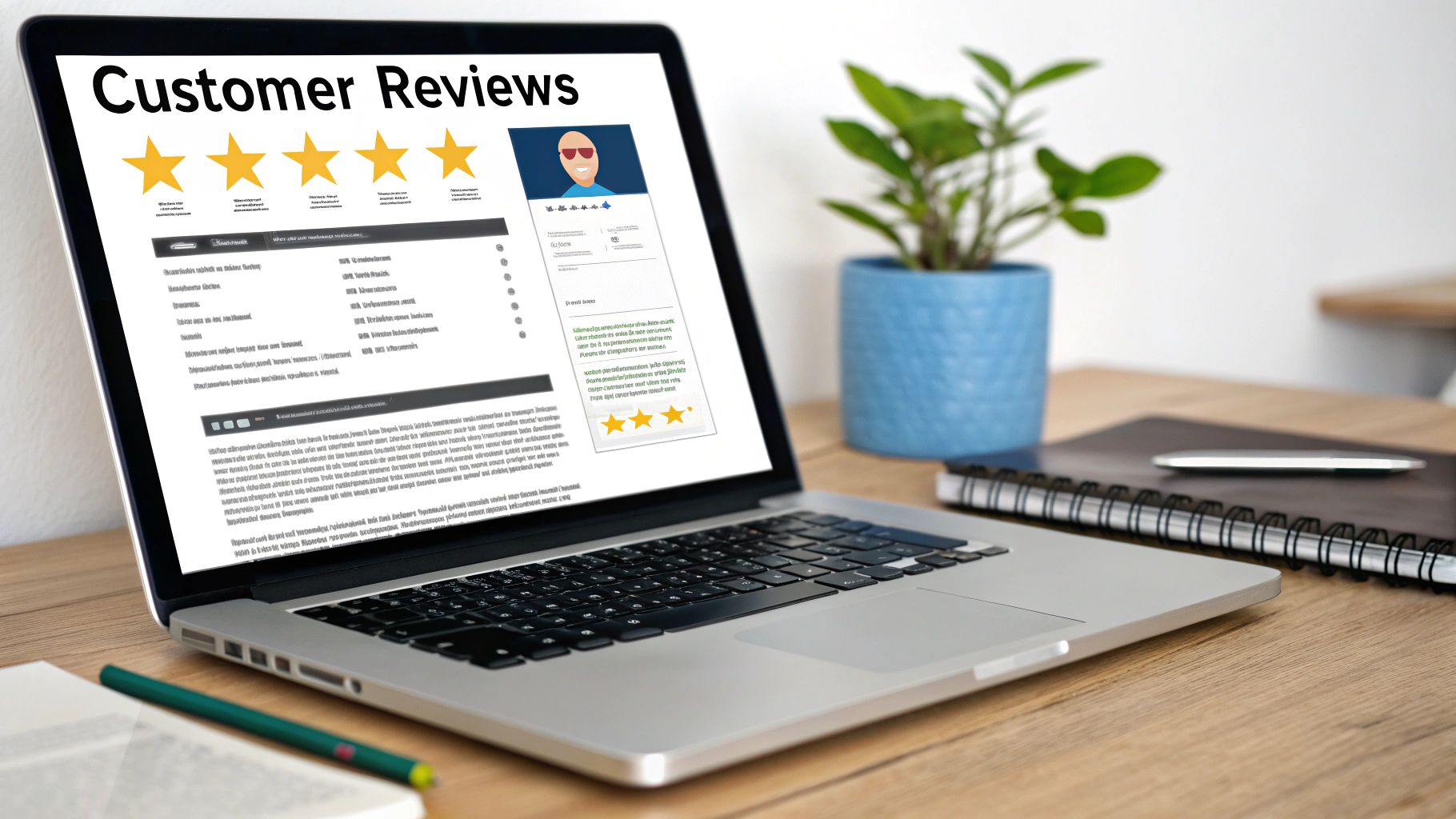
Add Your Location Throughout Your Website
Making your website "local" means more than just listing your address in the footer. You need to send clear signals on every page that you serve a specific community.
One of the easiest ways to do this is to embed a Google Map on your contact page. This creates a direct technical link between your site and your physical address, signaling "local business" to Google.
Next, conduct some localised keyword research to find out what people in your area are searching for. Then, naturally include these terms on your homepage, service pages, and blog posts.
Create Dedicated Pages for Multiple Locations
If you have more than one physical location, creating separate pages for each is essential. Do not list all your addresses on a single contact page.
Each location page should be a unique resource for that specific community.
- Unique NAP: It must have the specific Name, Address, and Phone number for that single location.
- Hyper-Local Content: Mention nearby landmarks, offer neighborhood-specific specials, and include testimonials from local customers.
- Embedded Map: Each location page needs its own embedded Google Map showing the exact spot.
- Local Photos: Add photos of the staff and storefront for that location.
This tells Google you have an established presence in each city, which helps you rank in multiple Map Packs.
Why Your Website's Health Matters
Google cares about user experience. Technical factors, like Core Web Vitals, play a big role.
Core Web Vitals are Google’s metrics for measuring a website's user experience. They look at loading speed, interactivity, and visual stability. A slow website creates a bad user experience, and Google may penalize you for it in local search results.
A fast, mobile-friendly website signals professionalism. These technical details are known ranking factors for local search and work with your local backlinks and NAP consistency to show Google you deserve a top spot.
Quick Fixes for a Healthier Website
You don't need to be a web developer to make improvements.
- Test for Mobile-Friendliness: Use Google's free Mobile-Friendly Test tool for a simple pass/fail grade.
- Compress Your Images: Large image files slow down your site. Use a free online tool to compress images before uploading them.
- Focus on "Above-the-Fold" Speed: Ensure the content that visitors see first loads almost instantly.
Connecting your website to your local SEO is a critical step. For small businesses, getting these on-page signals right is key. To learn more, check out our guide on local SEO services for small business.
Advanced Tactics to Beat the Competition
Once you have the basics down, it's time to get a competitive edge. Topping the Map Pack requires smart, proactive strategies that build authority and protect your rankings.
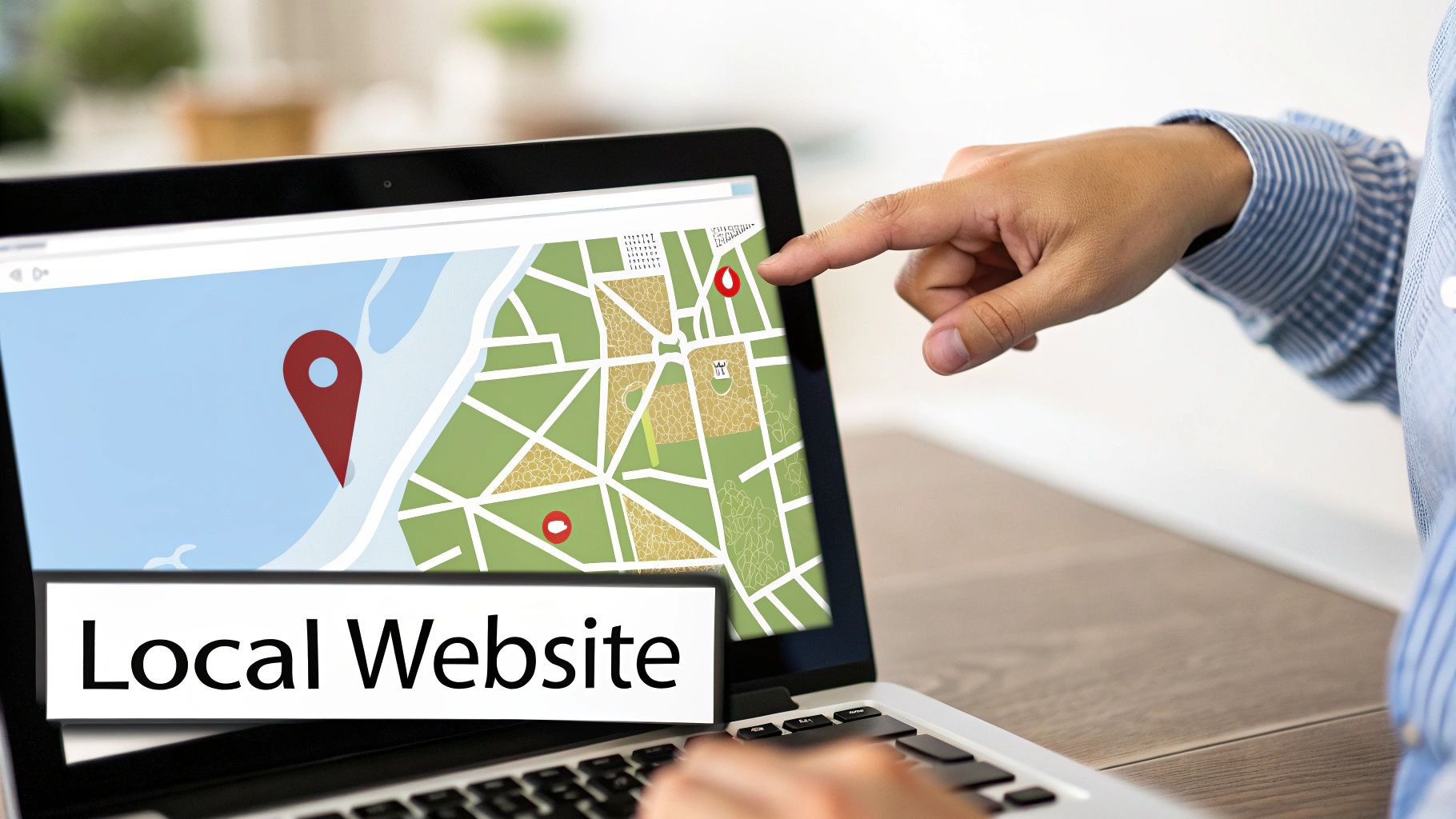
Earn Powerful Local Links
While general link building is good, local link building sends the specific trust signals Google wants for Map Pack rankings. The goal is to get links from respected businesses and organizations in your area.
These links act as a strong vote of confidence, telling Google you're an important part of the local community.
Here are a few ideas:
- Sponsor a local youth sports team. A link from their website is valuable.
- Host a community event and partner with a local non-profit.
- Join your local Chamber of Commerce for an easy directory link.
- Reach out to local bloggers or news outlets and offer an expert quote.
A single, high-quality local link can be more effective for your google map pack ranking than ten random links. You can explore a complete local maps SEO strategy to learn more.
Fight Back Against Map Spam
Sometimes competitors cheat. They might stuff keywords into their business name or use a fake address to compete in your area. This spam can push your legitimate business out of the top spots.
You can fight back. Use the "Suggest an edit" feature on their profile or, for serious issues, file a Business Redressal Complaint Form.
Provide proof. If a competitor is keyword stuffing, include a photo of their actual storefront sign. If they're using a fake location, take a picture of the address to prove they aren't there. Cleaning up map spam helps everyone.
Troubleshooting Common GBP Issues
Even with a perfect strategy, problems can arise. A sudden suspension or ranking drop can be stressful, but knowing how to handle common issues is key.
In Short: Stay calm and address the problem methodically. Panicking and changing everything at once can make things worse.
Here's a quick guide to common problems.
Common GBP Issues and How to Fix Them
| Issue | Potential Cause | What to Do First |
|---|---|---|
| Profile Suspension | A guideline violation (keyword stuffing, wrong address) or a Google glitch. | Read the suspension email carefully. Review the GBP guidelines, fix any issues, and then file a reinstatement request with proof. |
| Sudden Ranking Drop | New competitors, negative reviews, or a Google algorithm update. | Analyze top competitors—what have they changed? Review your recent reviews. Check for news about recent local algorithm updates. |
| Negative Review Bomb | A coordinated attack from a competitor or a single person with multiple accounts. | Respond politely to each review. Then, flag each one to Google for violating their fake engagement policies. |
Being prepared for these issues turns them into minor detours instead of crises.
People Also Ask About Advanced GBP Tactics
How do I report a competitor for a fake address?
Use "Suggest an edit" on their GBP listing and select "Doesn't exist here." If that fails, use the Business Redressal Complaint Form. Provide clear proof, like a photo of the address.
Why did Google suspend my profile after I made an update?
Simple edits like changing your address or primary category can sometimes trigger an automatic review. This is a security measure. Follow the reinstatement process and provide any documents Google requests.
Can I get a bad review removed?
Only if it violates Google's rules (e.g., spam, off-topic, hate speech). You cannot remove a review just because it's negative. Flag the review from your dashboard and explain why it violates policy.
Got Questions About Ranking in the Google Map Pack?
Even with a solid plan, questions will come up. Here are some straight answers to the most common questions about Google Map Pack ranking.
How Long Does It Take to Rank in the Map Pack?
Ranking in the Map Pack is not an overnight process. If you are starting a new business, it can take 3 to 6 months of consistent effort to see stable rankings.
If your business has been around for a while, you might see results faster, but it's never instant.
Several factors affect the timeline:
- Market Competition: Ranking is harder in a crowded market, like being one of 100 plumbers in a big city.
- Your Industry: Some fields, like law and home services, are highly competitive.
- Your Effort: Consistently getting reviews, building citations, and updating your profile will directly impact your ranking speed.
The bottom line: Ranking in the Map Pack is a marathon. It requires consistent, correct actions over several months.
Can I Rank in a City Where I Don’t Have a Physical Address?
The short answer is that it's very difficult. Google's local algorithm prioritizes proximity. It wants to show users businesses that are physically near them.
If you are a service-area business, you can hide your physical address on your GBP. However, you still need a verifiable address in that city to set up the profile, as Google will mail a verification postcard. A P.O. box is not sufficient.
Your energy is better spent dominating the area around your verified address rather than trying to rank in a neighboring city where you have no physical presence.
Why Did My Map Pack Ranking Suddenly Drop?
It can be alarming to see your ranking drop. Don't panic. A sudden drop in your Google Map Pack ranking usually has a specific cause.
Here’s what to check:
- New Competitors: A new business with a well-optimized profile may have entered the market.
- Review Issues: A recent string of negative reviews can hurt your ranking.
- Profile Changes: Did you recently change your business name, category, or address? Even small edits can trigger a re-evaluation by Google.
- A Google Update: Google frequently updates its local algorithm, which can shuffle the rankings.
Start by auditing your own profile. Then, look at the competitors who have moved ahead of you. This detective work will often reveal the problem and the solution.
Ready to stop guessing and start dominating the Map Pack? The team at Clicks Geek specializes in creating data-driven local SEO strategies that deliver real customers. Learn more about how we can grow your local business.
Is Your Business Ranking in Google Maps?
Turn Google Maps into a Lead Engine w/ Clicks Geek’s AI-powered local SEO. 3,000+ clients served. Our proprietary, fully done-for-you Maps SEO system handles everything—keyword targeting, local optimization, content, reviews, and ranking strategy—automatically.


